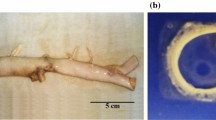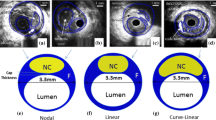Abstract
Stiffness of the arterial wall and atherosclerotic plaque components is a determinant of the stress field within plaques, which has been suggested to be an indicator of plaque vulnerability. The diversity and inhomogeneous structure of atherosclerotic lesions complicate the characterization of plaque components. In the present study, stiffness of the arterial wall and atherosclerotic plaque components in human coronary arteries was examined in early and developed atherosclerotic lesions. The force-spectroscopy mode of the atomic force microscope and histological examination were used for determination of elastic moduli at specified locations within samples. Fibrous cap (E = 14.1 ± 3.8 kPa) showed lower stiffness than the fibrous tissue beneath the lipid pool (E = 17.6 ± 3.2 kPa). Calcification zones (E = 96.1 ± 18.8 kPa) and lipid pools (E = 2.7 ± 1.8 kPa) were the stiffest and softest components of atherosclerotic lesions, respectively. The increase of media stiffness (%44.8) and reduction of the elastic modulus of the internal elastic lamina (%28.9) was observed in coronary arteries. Moreover, significant differences were observed between the stiffness of medial layer in diseased parts and free-plaque segments in incomplete plaques of coronary arteries. Our results can be used for better understanding of remodeling mechanisms of the arterial wall with plaque development.

Stiffness alteration of the arterial wall and atherosclerotic plaque components with plaque development in coronary arteries.




Similar content being viewed by others
References
Akyildiz AC, Speelman L, Gijsen FJ (2014) Mechanical properties of human atherosclerotic intima tissue. J Biomech 47:773–783
Ansardamavandi A, Tafazzoli-Shadpour M, Omidvar R, Jahanzad I (2016) Quantification of effects of cancer on elastic properties of breast tissue by atomic force microscopy. J Mech Behav Biomed Mater 60:234–242
Barrett S, Sutcliffe M, Howarth S, Li ZY, Gillard J (2009) Experimental measurement of the mechanical properties of carotid atherothrombotic plaque fibrous cap. J Biomech 42:1650–1655
Brown AJ, Teng Z, Evans PC, Gillard JH, Samady H, Bennett MR (2016) Role of biomechanical forces in the natural history of coronary atherosclerosis. Nat Rev Cardiol 13:210–220
Brüel A, Ørtoft G, Oxlund H (1998) Inhibition of cross-links in collagen is associated with reduced stiffness of the aorta in young rats. Atherosclerosis 140:135–145
Burke AP, Tavora F (2010) Practical cardiovascular pathology. Lippincott Williams & Wilkins
Burleigh MC, Brigfs AD, Lendon CL, Davies MJ, Born GV, Richardson PD (1992) Collagen types I and III, collagen content, GAGs and mechanical strength of human atherosclerotic plaque caps: span-wise variations. Atherosclerosis 96:71–81
Butt H-J, Cappella B, Kappl M (2005) Force measurements with the atomic force microscope: technique, interpretation and applications. Surf Sci Rep 59:1–152
Chai C-K, Akyildiz AC, Speelman L, Gijsen FJ, Oomens CW, van Sambeek MR, van der Lugt A, Baaijens FP (2013) Local axial compressive mechanical properties of human carotid atherosclerotic plaques—characterisation by indentation test and inverse finite element analysis. J Biomech 46:1759–1766
Chai C-K, Speelman L, Oomens CW, Baaijens FP (2014) Compressive mechanical properties of atherosclerotic plaques—indentation test to characterise the local anisotropic behaviour. J Biomech 47:784–792
Chatzizisis YS, Coskun AU, Jonas M, Edelman ER, Feldman CL, Stone PH (2007) Role of endothelial shear stress in the natural history of coronary atherosclerosis and vascular remodeling: molecular, cellular, and vascular behavior. J Am Coll Cardiol 49:2379–2393
Discher DE, Janmey P, Wang Y-l (2005) Tissue cells feel and respond to the stiffness of their substrate. Science 310:1139–1143
Doran AC, Meller N, McNamara CA (2008) Role of smooth muscle cells in the initiation and early progression of atherosclerosis. Arterioscler Thromb Vasc Biol 28:812–819
Ebenstein DM, Coughlin D, Chapman J, Li C, Pruitt LA (2009) Nanomechanical properties of calcification, fibrous tissue, and hematoma from atherosclerotic plaques. J Biomed Mater Res A 91:1028–1037
Finet G, Ohayon J, Rioufol G (2004) Biomechanical interaction between cap thickness, lipid core composition and blood pressure in vulnerable coronary plaque: impact on stability or instability. Coron Artery Dis 15:13–20
Fischer AH, Jacobson KA, Rose J, Zeller R (2008) Hematoxylin and eosin staining of tissue and cell sections. Cold Spring Harb Protoc 2008:pdb. prot4986
Gautier HO, Thompson AJ, Achouri S, Koser DE, Holtzmann K, Moeendarbary E, Franze K (2015) Atomic force microscopy-based force measurements on animal cells and tissues. Methods Cell Biol 125:211–235
Glagov S, Weisenberg E, Zarins CK, Stankunavicius R, Kolettis GJ (1987) Compensatory enlargement of human atherosclerotic coronary arteries. N Engl J Med 316:1371–1375
Gomez D, Owens GK (2012) Smooth muscle cell phenotypic switching in atherosclerosis. Cardiovasc Res 95:cvs115
Hayenga H, Trache A, Trzeciakowski J, Humphrey J (2011) Regional atherosclerotic plaque properties in ApoE–/– mice quantified by atomic force, immunofluorescence, and light microscopy. J Vasc Res 48:495–504
Holzapfel GA, Gasser TC, Ogden RW (2000) A new constitutive framework for arterial wall mechanics and a comparative study of material models. Journal of elasticity and the physical science of solids 61:1–48
Holzapfel GA, Sommer G, Regitnig P (2004) Anisotropic mechanical properties of tissue components in human atherosclerotic plaques. J Biomech Eng 126:657–665
Hutter JL, Bechhoefer J (1993) Calibration of atomic-force microscope tips. Rev Sci Instrum 64:1868–1873
Jufri NF, Mohamedali A, Avolio A, Baker MS (2015) Mechanical stretch: physiological and pathological implications for human vascular endothelial cells. Vasc Cell 7:8
Leach JR, Rayz VL, Soares B, Wintermark M, Mofrad MR, Saloner D (2010) Carotid atheroma rupture observed in vivo and FSI-predicted stress distribution based on pre-rupture imaging. Ann Biomed Eng 38:2748–2765
Lee RT, Grodzinsky AJ, Frank EH, Kamm RD, Schoen FJ (1991) Structure-dependent dynamic mechanical behavior of fibrous caps from human atherosclerotic plaques. Circulation 83:1764–1770
Loree HM, Tobias BJ, Gibson LJ, Kamm RD, Small DM, Lee RT (1994) Mechanical properties of model atherosclerotic lesion lipid pools. Arterioscler Thromb Vasc Biol 14:230–234
Maher E, Creane A, Sultan S, Hynes N, Lally C, Kelly DJ (2009) Tensile and compressive properties of fresh human carotid atherosclerotic plaques. J Biomech 42:2760–2767
Masuda H, Zhuang Y-J, Singh TM, Kawamura K, Murakami M, Zarins CK, Glagov S (1999) Adaptive remodeling of internal elastic lamina and endothelial lining during flow-induced arterial enlargement. Arterioscler Thromb Vasc Biol 19:2298–2307
McKee CT, Last JA, Russell P, Murphy CJ (2011) Indentation versus tensile measurements of Young’s modulus for soft biological tissues. Tissue Eng B Rev 17:155–164
Naghavi M, Libby P, Falk E, Casscells SW, Litovsky S, Rumberger J, Badimon JJ, Stefanadis C, Moreno P, Pasterkamp G (2003) From vulnerable plaque to vulnerable patient a call for new definitions and risk assessment strategies: part I. Circulation 108:1664–1672
O’callaghan CJ, Williams B (2000) Mechanical strain–induced extracellular matrix production by human vascular smooth muscle cells. Hypertension 36:319–324
Peloquin J, Huynh J, Williams RM, Reinhart-King CA (2011) Indentation measurements of the subendothelial matrix in bovine carotid arteries. J Biomech 44:815–821
Rezvani-Sharif A, Tafazzoli-Shadpour M, Avolio A (2018) Mechanical characterization of the lamellar structure of human abdominal aorta in the development of atherosclerosis: an atomic force microscopy study. Cardiovasc Eng Technol:1–12
Rezvani-Sharif A, Tafazzoli-Shadpour M, Kazemi-Saleh D, Sotoudeh-Anvari M (2016) Stress analysis of fracture of atherosclerotic plaques: crack propagation modeling. Med Biol Eng Comput 55:1–12
Shoajei S, Tafazzoli-Shahdpour M, Shokrgozar MA, Haghighipour N (2014) Alteration of human umbilical vein endothelial cell gene expression in different biomechanical environments. Cell Biol Int 38:577–581
Stary HC, Chandler AB, Dinsmore RE, Fuster V, Glagov S, Insull W, Rosenfeld ME, Schwartz CJ, Wagner WD, Wissler RW (1995) A definition of advanced types of atherosclerotic lesions and a histological classification of atherosclerosis a report from the committee on vascular lesions of the Council on Arteriosclerosis, American Heart Association. Circulation 92:1355–1374
Tang D, Yang C, Zheng J, Woodard PK, Saffitz JE, Sicard GA, Pilgram TK, Yuan C (2005) Quantifying effects of plaque structure and material properties on stress distributions in human atherosclerotic plaques using 3D FSI models. J Biomech Eng 127:1185–1194
Teng Z, Zhang Y, Huang Y, Feng J, Yuan J, Lu Q, Sutcliffe MP, Brown AJ, Jing Z, Gillard JH (2014) Material properties of components in human carotid atherosclerotic plaques: a uniaxial extension study. Acta Biomater 10:5055–5063
Tracqui P, Broisat A, Toczek J, Mesnier N, Ohayon J, Riou L (2011) Mapping elasticity moduli of atherosclerotic plaque< i> in situ</i> via atomic force microscopy. J Struct Biol 174:115–123
Varnava AM, Mills PG, Davies MJ (2002) Relationship between coronary artery remodeling and plaque vulnerability. Circulation 105:939–943
Vengrenyuk Y, Carlier S, Xanthos S, Cardoso L, Ganatos P, Virmani R, Einav S, Gilchrist L, Weinbaum S (2006) A hypothesis for vulnerable plaque rupture due to stress-induced debonding around cellular microcalcifications in thin fibrous caps. Proc Natl Acad Sci 103:14678–14683
Wentzel JJ, Chatzizisis YS, Gijsen FJ, Giannoglou GD, Feldman CL, Stone PH (2012) Endothelial shear stress in the evolution of coronary atherosclerotic plaque and vascular remodelling: current understanding and remaining questions. Cardiovasc Res 96:cvs217
Williamson S, Lam Y, Younis H, Huang H, Patel S, Kaazempur-Mofrad M, Kamm R (2003) On the sensitivity of wall stresses in diseased arteries to variable material properties. J Biomech Eng 125:147–155
Yuan J, Teng Z, Feng J, Zhang Y, Brown AJ, Gillard JH, Jing Z, Lu Q (2015) Influence of material property variability on the mechanical behaviour of carotid atherosclerotic plaques: a 3D fluid-structure interaction analysis. Int J Numer Method Biomed Eng 31
Zieman SJ, Melenovsky V, Kass DA (2005) Mechanisms, pathophysiology, and therapy of arterial stiffness. Arterioscler Thromb Vasc Biol 25:932–943
Acknowledgments
Authors thank Dr. Davood Kazemi-Saleh and Dr. Zahra Pourjafar at Baghiatallah Hospital for providing tissue specimens. Authors also thank Dr. Amirnader Emami Razavi at Tehran University of Medical Sciences for assistance in the preparation of samples for AFM test and determination of different components of atherosclerotic plaques and arterial wall layers in specimens.
Author information
Authors and Affiliations
Corresponding author
Rights and permissions
About this article
Cite this article
Rezvani-Sharif, A., Tafazzoli-Shadpour, M. & Avolio, A. Progressive changes of elastic moduli of arterial wall and atherosclerotic plaque components during plaque development in human coronary arteries. Med Biol Eng Comput 57, 731–740 (2019). https://doi.org/10.1007/s11517-018-1910-4
Received:
Accepted:
Published:
Issue Date:
DOI: https://doi.org/10.1007/s11517-018-1910-4




